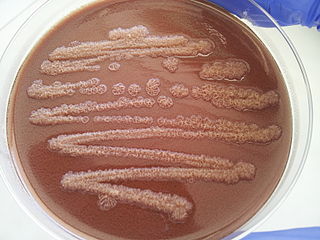
Pseudomonas is a genus of Gram-negative, Gammaproteobacteria, belonging to the family Pseudomonadaceae and containing 191 validly described species. The members of the genus demonstrate a great deal of metabolic diversity and consequently are able to colonize a wide range of niches. Their ease of culture in vitro and availability of an increasing number of Pseudomonas strain genome sequences has made the genus an excellent focus for scientific research; the best studied species include P. aeruginosa in its role as an opportunistic human pathogen, the plant pathogen P. syringae, the soil bacterium P. putida, and the plant growth-promoting P. fluorescens, P. lini, P. migulae, and P. graminis.
Pseudomonas segitis is a Gram-negative, aerobic soil bacterium found in Korea. The type strain is IMSNU 14101.
Pseudomonas moraviensis is a Gram-negative soil bacterium. It is named after Moravia, the region of the Czech Republic where it was first isolated. The type strain is CCM 7280T.
Pseudomonas lutea is a Gram-negative, strictly aerobic, non-spore-forming, motile, rod-shaped bacterium originally isolated from the rhizosphere of grasses in Spain. The type strain is LMG 21974.
Pseudomonas trivialis is a fluorescent, Gram-negative bacterium isolated from the phyllosphere of grasses. The type strain is DSM 14937.
Pseudomonas poae is a fluorescent, Gram-negative bacterium isolated from the phyllosphere of grasses. The type strain is DSM 14936.
Pseudomonas jinjuensis is a Gram-negative, non-spore-forming, motile, single polar flagellated, yellow-white, rod bacterium isolated from soil in the Jinju Region of Korea. The type strain is LMG 21317.
Pseudomonas koreensis is a Gram-negative, non-spore-forming, motile, multiple polar flagellated, yellow-white, rod bacterium isolated from farming soil in Korea. The type strain is LMG 21318.
Pseudomonas umsongensis is a Gram-negative, non-spore-forming, motile, single polar-flagellated, yellow-white, rod-shaped bacterium isolated from the soil in the Umsong region of Korea. The type strain is LMG 21317.
Pseudomonas panacis is a Gram-negative, aerobic, motile with one or more polar flagella, rod-shaped bacterium. It derives its name from the fact that it causes rusty root lesions on Korean ginseng, as the ginseng genus is Panax.
Pseudomonas peli is a Gram-negative, non-fluorescent, non-sporulating, motile, rod-shaped bacterium isolated from a commercially available nitrifying inoculum used in aquaculture. The type strain is LMG 23201. After approximately 24 hours of growth at 28 °C in Tryptic Soy Agar medium, Pseudomonas peli colonies are 1–2 mm in diameter, beige to yellow in color and have non-uniform edges while the cells themselves are rod shaped with rounded ends. Cells are motile, do not form spores, are non-fluorescent and they have not been observed to grow anaerobically.

Pseudomonas stutzeri is a Gram-negative soil bacterium that is motile, has a single polar flagellum, and is classified as bacillus, or rod-shaped. While this bacterium was first isolated from human spinal fluid, it has since been found in many different environments due to its various characteristics and metabolic capabilities. P. stutzeri is an opportunistic pathogen in clinical settings, although infections are rare. Based on 16S rRNA analysis, this bacterium has been placed in the P. stutzeri group, to which it lends its name.
Ilumatobacter coccineus is a Gram-positive, aerobic and non-motile bacterium from the genus of Ilumatobacter which has been isolated from sand from the beach of Shimane Prefecture in Japan.
Ilumatobacter nonamiensis is a Gram-positive, aerobic and non-motile bacterium from the genus of Ilumatobacter.
Thalassotalea litorea is a bacterium from the genus of Thalassotalea which has been isolated from seashore sand from the South Sea in Korea.
Croceitalea litorea is a Gram-negative, rod-shaped and non-motile bacterium from the genus of Croceitalea which has been isolated from seashore sand from the Jeju Island in Korea.
Sabulilitoribacter multivorans is a Gram-negative, aerobic and rod-shaped bacteria from the genus of Sabulilitoribacter which has been isolated from sand from the South Sea in Korea.
Arenimonas donghaensis is a Gram-negative and aerobic bacterium from the genus of Arenimonas which has been isolated from sand from Pohang in Korea.
Pseudoruegeria sabulilitoris is a Gram-negative, non-spore-forming, aerobic and non-motile bacterium from the genus of Pseudoruegeria which has been isolated from seashore sand from the Geoje Island in Korea.
Aquimarina versatilis is a Gram-negative, aerobic and rod-shaped bacterium from the genus of Aquimarina which has been isolated from seashore sand from Jeju island in Korea.

